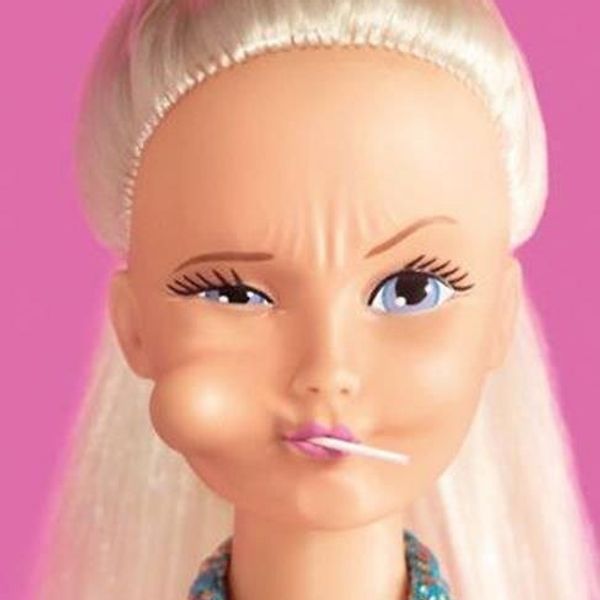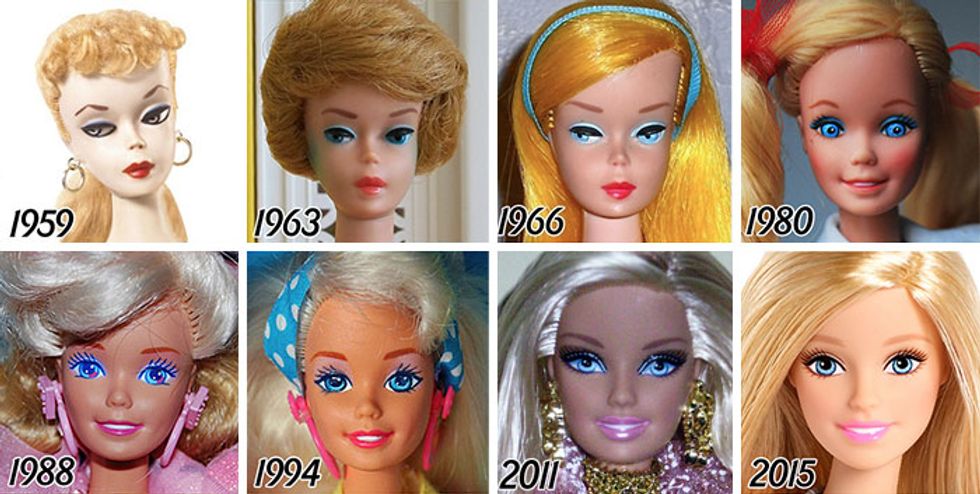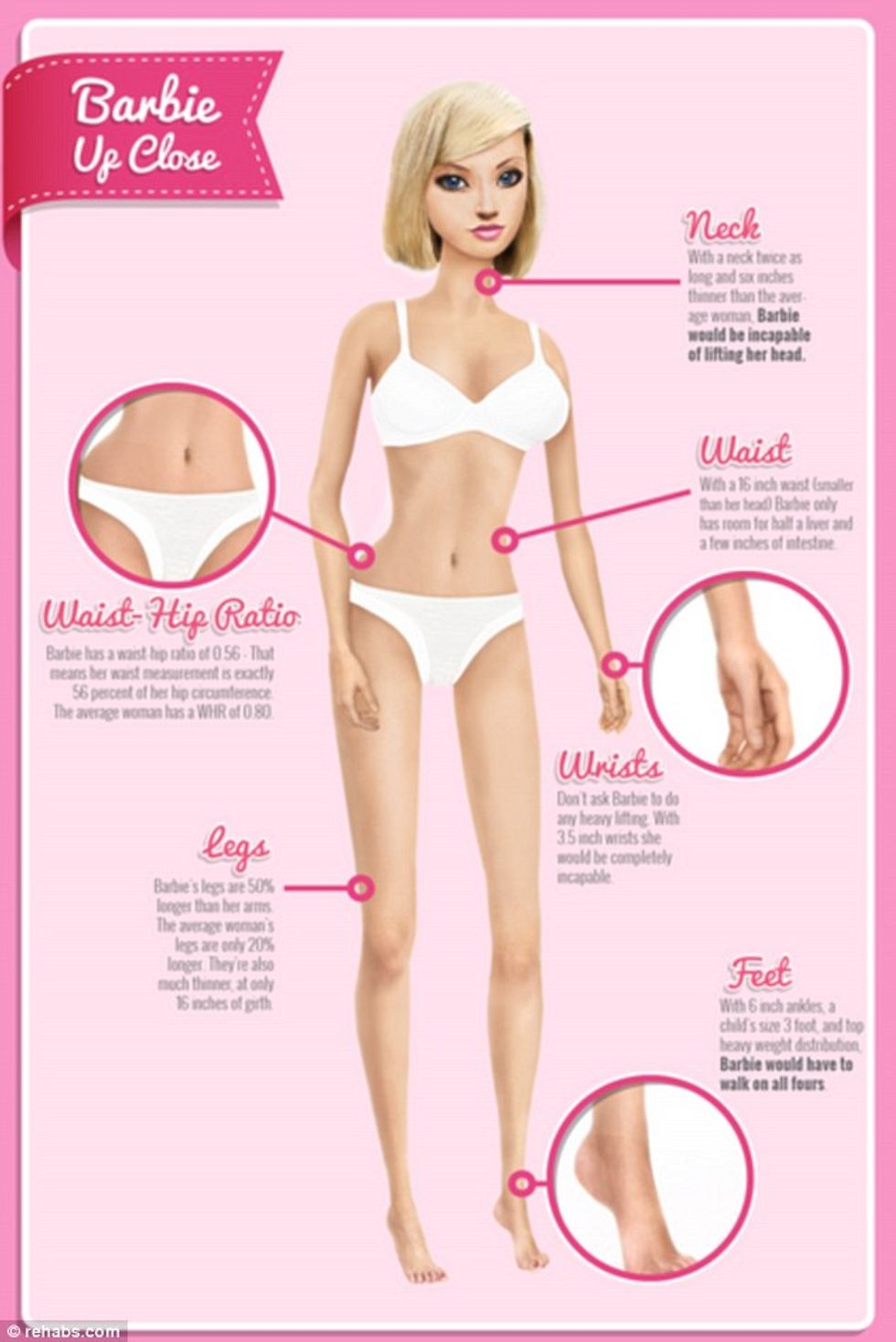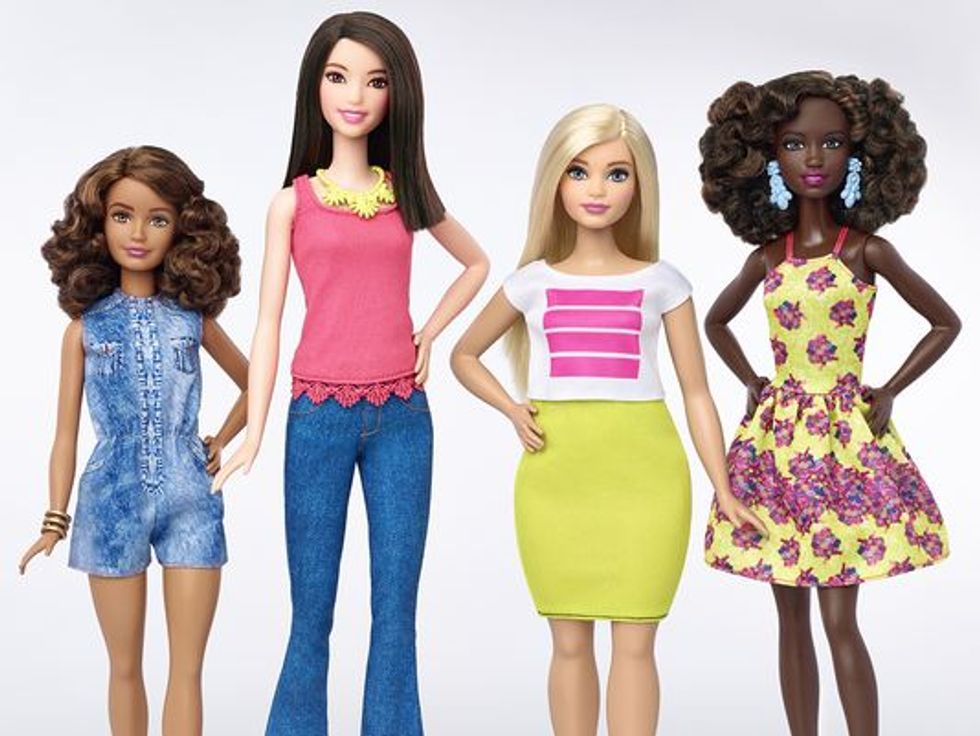Barbie, America’s best selling doll, has undergone many changes over the 50+ years since she appeared on store shelves. Her hair has progressed from a short bob in 1959 to full, voluminous waves. In the 1980s, she started to sport a smile. In the mid 1980s, the first black doll was introduced. Last year, Mattel made a huge step by introducing a new line of 23 fashionista dolls with “flat feet” as opposed to the feet that only fit into sky high heels, along with many different skin tones, hair colors, eye colors, and facial sculpts.
Fashion Style Mag
Barbie's Evolution
However, none of these changes were as significant as the one that Mattel recently announced. On Thursday, Jan. 28, Mattel announced that they were completely going to change the doll’s body. Instead of the classic, well-known body with a stick-thin waist, enormous bust and ultra-long legs, she was now going to come in three new shapes. These shapes— petite, tall, and curvy —were going to “give [her] a range of diverse looks that better reflect 21st century America.”
Let’s face it— Barbie’s body is not realistic in any way. According to researc, if Barbie were a real person she would have 16 inch thighs, 3.5 inch wrists, and a 16 inch waist. Physically, she would not even be able to lift her head and be required to walk on all fours. This presented a problem for young girls, as critics claimed that Barbie sends a message that one day, girls will grow up and have a body like hers, or that they need a body like Barbie’s to be successful in the real world. In this case, the fact that Mattel is taking this step to show that women come in several different body types is absolutely fantastic. However, I am not sure that this solution is necessarily the best way to approach the problem.
Daily Mail
If Barbie were a real woman
No secret: I was a huge Barbie collector as a child. I owned several different types of Barbies, and they came in many different professions and personas— from the cheerleader doll I received for my third birthday to “Dr. Barbie,” an obstetrician doll complete with a doctor’s coat and twin “babies.” I loved to play pretend and use her to bring my imagination to life. But I would never say that I looked up to her or aspired to look just like her when I was older. I realized early on that Barbie's body did not look like those of the women around me and I and I didn’t expect that I would ever attain that body, nor did I want to— I mean, who would want to have a head that they can’t hold up with their own neck and heels that cannot touch the ground? I did not look up to American Girl dolls, Polly Pockets, Bratz, or any other of the many dolls I played with either. I looked up to the real women in my life— my mom, female relatives, teachers, camp counselors, older teammates and friends. I was always aware that dolls were meant to be toys and to be played with, not to serve as role models. The enjoyment from playing with dolls came from the fact that it was all pretend— I could make believe anything I wanted to. I never actually looked up to them or thought I had to look or dress like them.
However, just because I did not feel pressured to look like a Barbie, does not mean there are not many girls who do. A 2006 study showed that girls who were exposed to Barbie reported lower esteem with their bodies and more desire for a thinner shape than girls who were exposed to either dolls with a larger figure or no dolls at all. That is why Mattel has decided to introduce these new body types, and it is great that they are trying to set a better example. However, it does not completely fix the problem, and in fact, I believe it creates another one.
The core of the problem lies in the fact that they have released only three body types. Now, there are absolutely way too many body types in the world for any doll company to be able to replicate all of them. Everyone has a genuinely unique body, and does not necessarily fit into the societal labels such as “apple,” “pear,” or “hourglass.”
The issue is not the fact that Mattel is not catering to more body types, because it would be virtually impossible to cater to every body type without making anyone upset. The problem is that with these three new dolls, they are creating more labels. For example, the new “tall” doll is still very thin— not every girl who is tall is also stick thin. On the flip side, the “curvy” doll is fairly short— not every girl who considers themselves “curvy” is short. In addition, the “curvy” doll’s body is not even that much more curvy than the original Barbie’s.
USA Today
Petite, tall, curvy, and original Barbies
The truth is that four body types (including the original, which will still be sold) is both too many and too few at the same time. It is too few in the sense that the new labeled body types do not cater enough real body types— not everyone has a body that is either tall, curvy, petite, or looks like the original Barbie’s (well, no one has that one). At the same time, however, making even more body types for the dolls would possibly cause even further problems. It would create even more labels, and there would still be many girls who do not fit into those specific categories.
The reason that Original Barbie’s body has created self-esteem issues for girls is because her body was created to look like society’s “ideal” body. Time Magazine ranks Barbie as being the second most influential toy of all time, exclaiming, “Barbie was the first incarnation of the adult version of a doll that would allow girls to envision, ‘What do I want to be when I grow up?’ besides a mom.” Mattel claims that a Barbie is sold every three seconds. It makes sense that girls who play with these dolls would be disappointed with their bodies, possibly feeling as if they cannot do everything Barbie can if they do not possess her figure. Mattel succeeds in trying to solve this problem by creating body types that are more realistic, and are more likely similar to those of real girls— but how does it help the millions of girls whose bodies still do not look like a Barbie’s?
While it is undoubtedly great that girls now have a few different options for dolls to buy, as opposed to just one who possesses an extremely unrealistic figure, there is a chance that presenting a variety of dolls could pose even more of a threat to girls’ self-esteem. Original Barbie, who has what society sees as an “ideal” body, was not a good example for any girl. The three new types may be better role models for some girls, but not for the many girls who do not consider themselves to be petite, curvy or tall. If girls have the impression that Original Barbie possesses the “ideal” body, the only thing that is accomplished by making more dolls is creating more “ideal” body types. While this is obviously not Mattel’s intention, there are still going to be many young girls who are upset about their bodies— and instead of it being because they do not fit one ideal body type, it is now even worse— they now feel like there are four “good” body types, and they do not fit into any of them. So, the new dolls are not helping these girls’ body esteems any more than Original Barbie’s ever was.
Now, don't get me wrong. I'm not saying that they should have just kept the old Barbies and not made any improvements at all. I think it is absolutely fantastic that Mattel took this step, and I applaud them for it; however, I think that by trying to release multiple body types, they are going to please some people and marginalize many others who do not fit into those types.
There is no perfect solution to this problem, although I do think that many of the negative criticism that Barbie has received could have been eliminated if Original Barbie’s body was not so unrealistic from the beginning. If she did not have features that called so much attention to her body, such as her bust, ultra-long legs, and large head, then maybe girls would not have focused so much on her body in the first place, and how different her body looks from their own.
The real core of the problem has nothing to do with Barbie herself. Barbie is a doll— a toy that is supposed to be used for children to play pretend with and use their imagination. It is not the doll’s, or even Mattel’s, fault that Barbie’s body was created the way it was— it is society’s never-ending preoccupation with looks and image. The reason that Barbie’s body is so unrealistic is because that is the body that is seen as “perfect” in society, and toymakers get the impression that a toy will be more appealing if it fits a certain stereotype. Our media and image-obsessed culture are what have us preoccupied with our bodies, and Barbie is just a product of that. While there has been lots of controversy over this issue, the truth is that our society is what is responsible for the body image problems that are caused by Barbies, not the dolls themselves. Mattel can make as many changes as they want to to the dolls, but the problem will not be fixed until society’s body problem is.
























